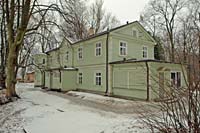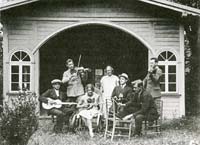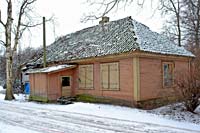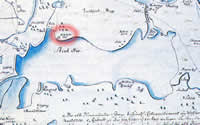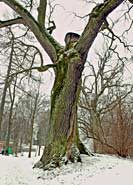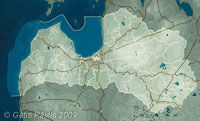
| Coordinates: | 57°00'05,10'' N 24°10'27,97'' E Google Maps |
| No: | 110 (list of all monuments) |
| Category: | Palaces and manor houses |
| Address: | Riga, Mezaparks, in Saulesdarzs, south from A.Sakse Street |
| Versions of name: | Saules darzs, Gravu manor, Gravenhofa, Gravenhof, Hillebolts Hof |
| Year of construction: | ? |
| Condition: | Good, reshaped |
| Value: | Architecture |
| Conservation status: | Not protected |
Although Grave manor house has been reshaped, it is still standing. Next to it there are located Neo-Gothic gazebo and another household building - both in critical condition.
In 1678 grave manor belonged to town councillor Johann Hillebold, in 1693 - to prefekt Gerhard Gren, in 1725.gadā - the the eldest of Great Guild Valentīin Grave, Manor house got its present name from the last. In the map of Riga and its vicinities from 1791 next to this manor there is symbol which designated agricultural manor
At late 19th century - early 20th century this manor was property of Patrik Ruetz. He was a relative to the publisher of the popular newspaper "Rigasche Rundschau" and as a result in this newspaper often appeared pictures of Kisezers Lake. at these times in the manor there was beautiful, wast park, in late 19th century as a gardener there worked Latvian Johans Vildfangs with his family and two assistants.
In 1913 manor house per 200 000 roubles was purchased from the heirs of Ruetz by the Latvian Society of Education and renamed this property to Saules darzs - Garden of Sun. This name was given due to sundial in the park. Latvian intellectuals granted significant sums to education of youth and development of sports activities, in this garden there were built comfortable buildings for sports, music platform, park was tended even more beautiful and whole area quickly became very popular among Latvian of Riga city. Further development of Saules darzs was terminated by the First World War but performances in the wartime continued, here was arranged a shelter for the children of soldiers.
Between both World Wars in Saules darzs there continued active cultural life in Saules darzs, especially popular was the traditional Children's Festival. But, as in the 1930ies state improved the organisation of the activities for youth, performances in Saules darzs were less popular - numerous well organised events took place in other places as well. Society was exhausted and often the activities in Saules darzs were criticised until in 1936 Saules darzs was alloted to Mazpulks - state organised union for children.
In 1945 Saules darzs was renamed to Bernu parks - Children's Park. The first director after the war was Julijs Pamiljens - he arranged a beautiful garden here but in in 1948 he had to leave his position - he made a politically unacceptable joke about the fact that in the Red Corner (obligatory room with visual aids for "political education" during the Soviet occupation times) there is no red color. Still the performances for children continued and were popular. In 1963 there was estabished a new institution - Central Station for Young Naturalists "Saulesdārzs". Unfortunately in Soviet time the area of Sauledarzs slowly degraded and buildings were not well tended. Pond was filled up and pavilion next to it - dismantled, beautiful embankment of Kisezers Lake was destroyed step by step.
When the independence of Latvia as renewed, area was alloted to the Centre of Young Nature Friends "Saulesdārzs" and other childrens organisations.
In 2000 there was started a process which resulted in transfer of Saulesdarzs to a group of private persons. Nowadays in this manor there is located Youth Football Centre "Skonto", area towards the lake has been built up.
Images
References
- Kaupuža D. Rīgas muižiņas. Latvijas architektūra, Rīga, 2005, p.95.
- Jakovičs A. Rīgas ekotūrisma atlants, vsited on 20th June 2009
- Viese S. Mežaparks, pilsēta priežu silā, Rīga, Jumava, 2001, p.23.
- Broce J.K. Zīmējumi un apraksti, 2.sējums, Rīga, Zinātne, 1996, p.462.
- Rīgas ielas, enciklopēdija, 3.sējums, Rīga, 2009.g., p.13.


